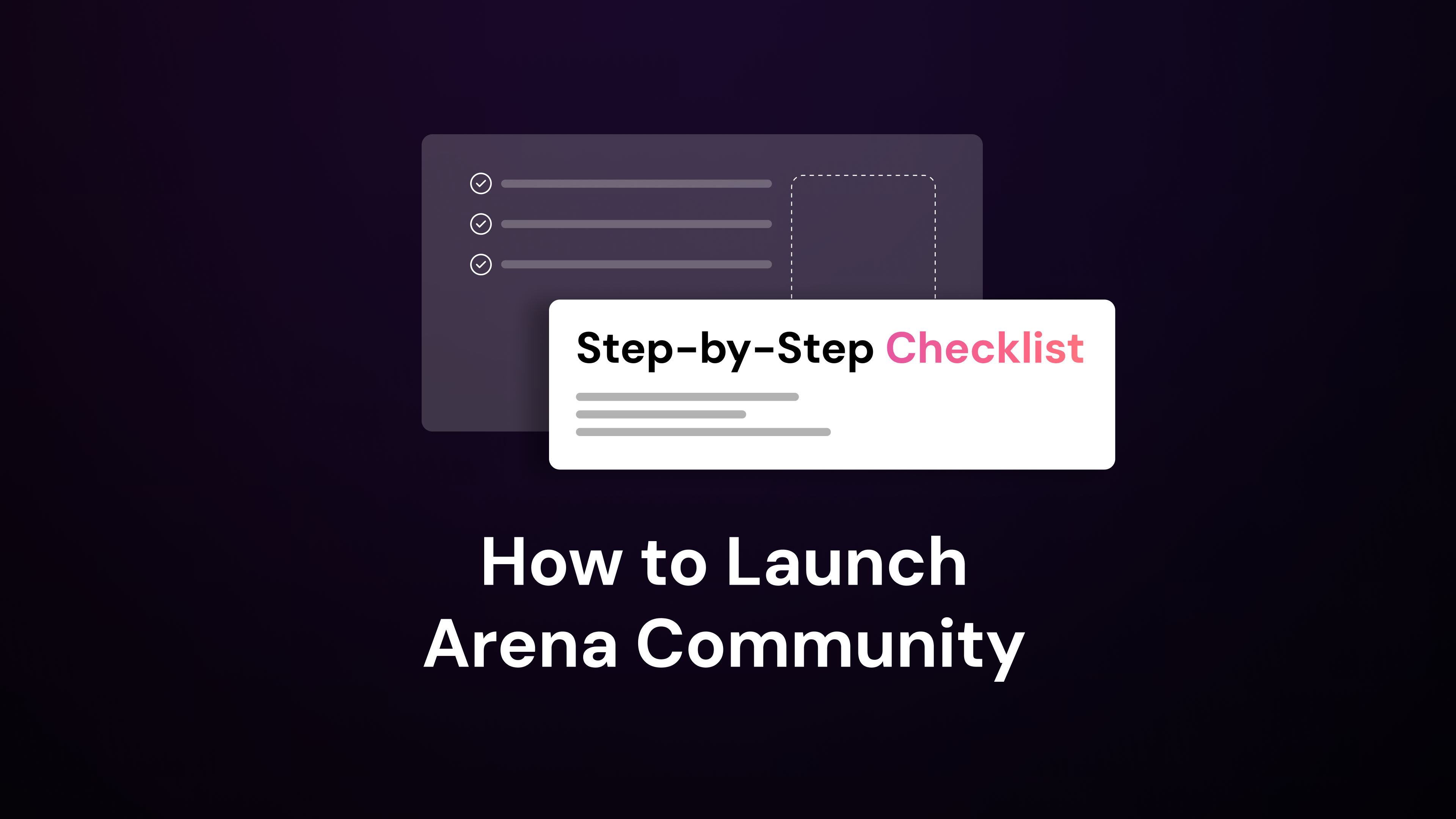In this article, we go over seven prerequisites for creating a brand community that engages people, promotes growth, and encourages loyalty.
1. Define Clear Goals and Metrics for Your Community
Before starting your brand community, set specific goals and decide how you’ll measure success. This ensures your efforts align with your business objectives.
Determine Success Criteria for Your Community
Decide what you want your community to accomplish. Are you aiming to increase customer engagement, boost sales, or enhance brand loyalty? Defining clear goals helps you focus your efforts and track progress effectively. Consider objectives like:
- Increasing community engagement levels
- Raising customer satisfaction scores
- Improving referral rates
- Decreasing customer service inquiries
Understanding and implementing a community flywheel for growth can help you sustain momentum and achieve these goals. By outlining what success means, you can monitor key metrics and make informed decisions to improve your community.
Align Goals with Business Objectives
Ensure your community goals support your company’s broader objectives. For example, if your business wants to improve customer retention, focus your community on building loyalty and providing exclusive value to members. Recognizing the difference between customer vs audience engagement can help tailor your strategies effectively. Aligning community goals with business priorities helps your community contribute to growth and success.
Setting clear goals and aligning them with your business objectives provides a strong foundation for your brand community. It helps you stay focused, measure progress, and demonstrate the value of your community to stakeholders. For a deeper understanding, explore defining customer engagement to connect effectively with your audience.
2. Establish a Clear Brand Identity and Values
Understanding what your brand represents is crucial before building a community.
Clarify Your Mission and Core Values
Your brand’s mission and core values form the basis of your community. Clearly state your purpose, goals, and guiding principles to attract like-minded individuals. Consider:
- What your brand aims to achieve
- Who are you helping
- The values that drive your actions
Implementing effective customer engagement strategies can align your mission with your audience’s needs. A well-defined identity resonates with your audience and helps create a cohesive community.
Share Your Brand Story with the Community
Sharing your brand’s story builds deeper connections with community members. Openly communicate your journey, challenges, and successes to foster trust and authenticity. Invite members to share their stories and experiences related to your brand. This exchange strengthens relationships and creates a sense of belonging.
3. Identify Your Target Audience
To build a successful brand community, you must understand your ideal members.
Conduct Audience Research
Analyze your existing customers and social media followers. Look for patterns in their demographics, online behaviors, and interests. Tools like Google Analytics and social media insights can help gather valuable data. Engage with your audience through surveys or polls to learn about their needs and interests. Observing successful online communities can provide insight into effective engagement strategies.
Create Detailed Personas
Use the information from your research to create detailed personas representing segments of your target audience. Include details such as age, occupation, goals, challenges, and preferences. These personas help you tailor your community’s tone, content, and engagement strategies to resonate with your audience. By understanding who you’re building the community for, you can ensure it meets their expectations and encourages participation.
4. Develop a Community Engagement and Content Strategy
An effective engagement and content strategy is essential for building an active brand community. By planning engaging content and setting clear interaction guidelines, you can encourage participation and meaningful connections among members.
Plan Engaging Content
Creating valuable content keeps your community interested and involved. Develop a content plan that addresses the needs and interests of your members:
- Provide informative and relevant content: Share industry insights, how-to guides, and expert advice that resonate with your audience.
- Encourage user-generated content: Invite members to contribute by sharing their experiences, ideas, and feedback. Implementing user-generated content strategies can enhance engagement.
- Showcase member contributions: Highlight testimonials, reviews, and creative works from your community members.
- Maintain consistent posting: Regularly update your community with fresh content to keep members engaged.
Integrating community tactics and tools and focusing on building thriving online communities can significantly boost your community’s growth.
Set Interaction Guidelines
Establishing clear interaction guidelines helps create a positive and respectful environment where members feel safe to participate:
- Define acceptable behavior: Outline expectations for respect, language, and conduct. Ensuring GDPR compliance is also crucial for protecting member data and privacy.
- Outline moderation policies: Explain how you will handle conflicts, inappropriate content, or guideline violations. Learn more about maintaining community safety to keep your community secure.
- Promote open communication: Encourage members to share their thoughts and opinions while maintaining a supportive atmosphere.
- Make guidelines accessible: Ensure that your interaction guidelines are easy to find and understand.
By planning your content thoughtfully and setting clear guidelines, you establish the foundation for an engaged brand community. This strategy fosters loyalty and encourages meaningful interactions that support your business goals.

5. Dedicate Resources for Community Management
Building a successful brand community requires dedicated management resources. Assigning specific roles and providing the right tools ensures the community remains active, engaged, and aligned with your brand’s mission.
Assign Community Roles
Designate team members to oversee and nurture your community:
- Community Managers: Facilitate interactions, encourage participation, and keep discussions meaningful.
- Moderators: Monitor conversations, enforce guidelines, and maintain a respectful environment.
- Support Staff: Address member questions and provide assistance promptly.
Having dedicated personnel promotes consistent engagement and helps build strong relationships within the community.
Provide Tools for Managers
Equip your team with the necessary tools to manage the community effectively:
- Management Platforms: Choose software that offers moderation features, analytics, and scalability.
- Analytics Tools: Use data to track engagement levels and understand member behavior.
- Communication Channels: Provide internal channels for the team to coordinate efforts.
Understanding the importance of controlling your data empowers your managers to enhance the community experience while ensuring data security. Investing in the right tools empowers your managers to enhance the community experience and support its growth.
6. Participate in the Community
Active involvement is key to nurturing a successful brand community.
Foster Open Communication
Create an environment where members feel comfortable sharing their thoughts and feedback. Listen actively and respond to their input to show that their voices matter. By participating in conversations and valuing member contributions, you build trust and deepen connections within the community.
Engage Consistently with Members
Maintain regular interaction to keep the community engaged. Plan how you will interact with members consistently:
- Respond promptly to questions and comments.
- Participate in discussions.
- Encourage members to share their content and experiences.
Utilizing effective community engagement tactics can keep your community vibrant and interactive. Consistent engagement demonstrates your commitment to the community and strengthens relationships.
7. Provide Exclusive Value to Members
To keep your brand community active, it’s important to offer something they can’t get elsewhere. Providing exclusive value gives members a compelling reason to stay engaged and connected.
Offer Unique Content and Experiences
Create content that resonates with your community. This might include:
- Exclusive articles or videos that delve into topics your audience cares about.
- Behind-the-scenes access to upcoming products or company developments.
- Early access to new features or announcements before they’re public.
- Special events or webinars tailored specifically for community members.
Offering unique content and experiences makes your community a place where members feel valued.
Create Participation Incentives
Encourage active participation by rewarding members for their involvement. Consider:
- Offering discounts or special offers to those who contribute regularly.
- Implementing a points or badges system to recognize and showcase member contributions.
- Hosting contests or challenges that inspire creativity and engagement.
- Highlighting member achievements or featuring user-generated content in your communications.
These incentives motivate members to engage more deeply and strengthen their connection to your brand.
By focusing on these key steps—defining clear goals, establishing your brand identity, understanding your target audience, crafting an engaging strategy, dedicating resources, actively participating, and providing exclusive value—you can build a strong brand community that promotes loyalty and growth. Embracing these foundational steps will enhance your interactions with your audience and strengthen your brand’s online presence.
Ready to see the impact of an effective brand community on your bottom line? Sign up now at Arena and start leveraging our powerful features to boost engagement and retention. Join thousands of brands that trust Arena to turn visitors into loyal customers.



